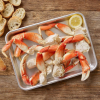For those who understand spanish these are the reasons that hundreds of thousands of argentinians are currently in Europe .
[
Image](
https://agendarweb.com.ar/wp-content/uploads/2020/03/supermercado_GONDOLA-scaled.jpg)
«Llevamos a cabo un relevamiento en toda Argentina, en cadenas de supermercados y autoservicios. El kilo de bananas provenientes de Ecuador no baja de los $ 2.000. Sin embargo, a nivel mundial, el valor nunca pasa U$S 1,30. Tenemos el producto importado más caro del mundo» sostuvo el doctor
Javier Miglino.
Actualmente, en nuestro país se consumen 10 kilos de bananas por habitante y por año. Estamos muy lejos de los 25 kilos que se comían en la década del ’90. Argentina no las produce. Suele importarlas desde Ecuador, Honduras y Guatemala.
ImageU$S 2,5 el precio de cada kilo de banana al cambio oficial en ArgentinaU$S 2,5 el precio de cada kilo de banana al cambio oficial en Argentina
En Francia, la banana ecuatoriana cuesta un euro el kiloEn Francia, la banana ecuatoriana cuesta un euro el kilo
¿Quién se ha quedado con mi queso?
“A nuestros estudios sumamos las fiambrerías de barrio para medir el precio de los quesos contra el valor internacional de este lácteo. Otra vez encabezamos el ranking«, sostuvo el doctor Miglino.
En Argentina se consumían en la década del ’70 unos 12 kilos de queso por persona y por año. Hoy, el consumo bajó a 4 kilos debido a sus altos precios. En las preferencias marchan adelante el port salut, provolone, reggianito y la muzzarella que se usa para la pizza casera.
Determinados tipos de queso pasaron a ser artículos de lujo en los súper Determinados tipos de queso pasaron a ser artículos de lujo en los súper
Frozen, precios que te dejan congelado
En el caso de los helados, nos ganamos otro título del mundo debido a nuestros valores locales.
El precio de 1 kilo ha quedado en un promedio de $ 16.000. Con un dólar oficial a $1.000 equivale a 16 dólares, por encima de cualquier país.
Miglino tuvo en cuenta tanto heladerías artesanales como industriales.
En nuestro país se consumían en la década del ’70 unos 12 kilos de helado por persona y por año. En 2024, el consumo bajó a la mitad. Se suma a la cuestión de los precios el cuidado de la salud ya que se trata de un alimento rico en azúcar y calorías.
Con el precio de los helados Argentina lidera tambièn el ranking mundial Con el pecio de los helados Argentina lidera tambièn el ranking mundial
Con el sachet de leche, Argentina no dice ni «mu»
La consultora tomó como referencia un tipo de leche entera cuyo valor promedio en 15 provincias de la Argentina se ubica por encima de un Euro, al cambio oficial.
Mientras tanto,
los avisos en medios de España y Francia demuestran que en el viejo continente este producto vital se vende más barato: no llega a un Euro por litro.
ImageImageImage## Cada jornada, la mitad de los argentinos se despiertan con un café
Finalmente, se escanearon precios de marcas líderes de cápsulas de café en distintas provincias de nuestro país**.**
Las 10 cápsulas representan aquí U$S 12 liderando cómodamente el ranking global muy por encima de España, Francia y la propia Italia.
Image



